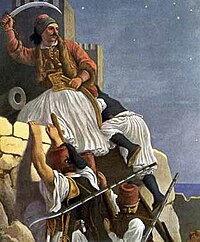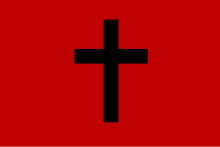
The Greek War of Independence, also known as the Greek Revolution or the Greek Revolution of 1821, was a successful war of independence by Greek revolutionaries against the Ottoman Empire between 1821 and 1829. In 1826, the Greeks were assisted by the British Empire, Kingdom of France, and the Russian Empire, while the Ottomans were aided by their vassals, especially by the Eyalet of Egypt. The war led to the formation of modern Greece, which would be expanded to its modern size in later years. The revolution is celebrated by Greeks around the world as independence day on 25 March.

A series of military conflicts between the Ottoman Empire and various European states took place from the Late Middle Ages up through the early 20th century. The earliest conflicts began during the Byzantine–Ottoman wars, waged in Anatolia in the late 13th century before entering Europe in the mid-14th century with the Bulgarian–Ottoman wars. The mid-15th century saw the Serbian–Ottoman wars and the Albanian-Ottoman wars. Much of this period was characterized by the Ottoman expansion into the Balkans. The Ottoman Empire made further inroads into Central Europe in the 15th and 16th centuries, culminating in the peak of Ottoman territorial claims in Europe.
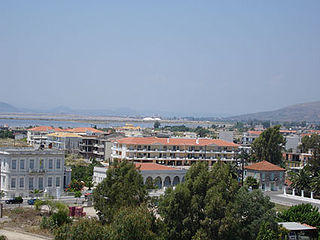
Missolonghi or Mesolongi is a municipality of 32,048 people in western Greece. The town is the capital of Aetolia-Acarnania regional unit, and the seat of the municipality of Iera Polis Mesolongiou. Missolonghi is known as the site of a dramatic siege during the Greek War of Independence, and of the death of poet Lord Byron.

The Great Turkish War or The Last Crusade, also called in Ottoman sources The Disaster Years, was a series of conflicts between the Ottoman Empire and the Holy League consisting of the Holy Roman Empire, Poland-Lithuania, Venice, Russia, and the Kingdom of Hungary. Intensive fighting began in 1683 and ended with the signing of the Treaty of Karlowitz in 1699. The war was a resounding defeat for the Ottoman Empire, which for the first time lost substantial territory, in Hungary and the Polish–Lithuanian Commonwealth, as well as in part of the western Balkans. The war was significant also for being the first instance of Russia joining an alliance with Western Europe. Historians have labeled the war as the Fourteenth Crusade launched against the Turks by the papacy.

Markos Botsaris was a Souliot chieftain, general of the Greek revolutionary army and hero of the Greek War of Independence. He played a key role in relieving the First Siege of Missolonghi in 1822–1823 and was awarded the title of General of Western Greece by the revolutionary Greek government. He was killed during the Battle of Karpenisi and was buried in Missolonghi with full honors. Today Botsaris is among the most revered national heroes in Greece.

The Siege of Adrianople, was fought during the First Balkan War. The siege began on 3 November 1912 and ended on 26 March 1913 with the capture of Edirne (Adrianople) by the Bulgarian 2nd Army and the Serbian 2nd Army.
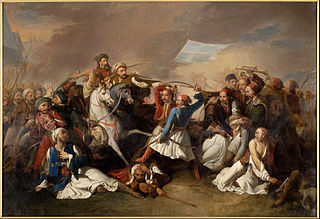
The Battle of Karpenisi took place near the town of Karpenisi on the night of 21 August 1823, between units of the Greek revolutionary army and Ottoman troops.

Methoni, formerly Methone or Modon, is a village and a former municipality in Messenia, Peloponnese, Greece. Since the 2011 local government reform it is part of the municipality of Pylos-Nestor, of which it is a municipal unit. The municipal unit has an area of 97.202 km2. Its name may be derived from Mothona, a mythical rock. It is located 11 km south of Pylos and 11 km west of Foinikounta. The municipal unit of Methoni includes the nearby villages of Grizokampos, Foinikounta, Foiniki, Lachanada, Varakes, Kainourgio Chorio, Kamaria, Evangelismos, and the Oinnoussai Islands. The islands are Sapientza, Schiza, and Santa Marina; they form a natural protection for Methoni harbour.
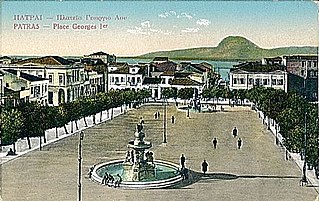
The city of Patras has an important history of four thousand years. Patras has been inhabited since the prehistoric age and constituted an important centre of the Mycenean era. In antiquity it was a leading member of the Achaean League. Patras reached the peak of its power in the Roman era, when an imperial colony was founded there by Augustus. In the Byzantine period it remained a commercial city. The town experienced repeated conquests from Franks, Venice, Byzantines and finally the Ottomans. Later on, it played a leading part in the Greek revolution of 1821, the first revolt of which in Greece, broke out in Patras. In 19th century Greece, it was the indisputable centre of the Peloponnese, an important export harbour, and a cradle of the emerging Greek middle class. In the 20th century the city developed as a commercial and industrial hub and in spite of its overshadowing by Athens, it is now the third city of Greece and the most significant economic pole of Peloponnese and West Greece.

The Battle of Dervenakia was the Greek victory over the Ottoman forces on 6–8 August 1822, an important event in the Greek War of Independence.

Reşid Mehmed Pasha, also known as Kütahı, was an Ottoman statesman and general who reached the post of Grand Vizier in the first half of the 19th century, playing an important role in the Greek War of Independence.
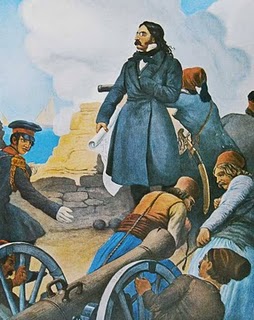
The First Siege of Missolonghi was an attempt by Ottoman forces to capture the strategically located port town of Missolonghi during the early stages of the Greek War of Independence.

The Habsburg monarchy and the Ottoman Empire waged a series of wars on the territory of the Kingdom of Hungary and several adjacent lands in Southeastern Europe from 1526 to 1568. The Habsburgs and the Ottomans engaged in a series of military campaigns against one another in Hungary between 1526 and 1568. While overall the Ottomans had the upper hand, the war failed to produce any decisive result. The Ottoman army remained very powerful in the open field but it often lost a significant amount of time besieging the many fortresses of the Hungarian frontier and its communication lines were now dangerously overstretched. At the end of the conflict, Hungary had been split into several different zones of control, between the Ottomans, Habsburgs, and Transylvania, an Ottoman vassal state. The simultaneous war of succession between Habsburg-controlled western "Royal Hungary" and the Zápolya-ruled pro-Ottoman "Eastern Hungarian Kingdom" is known as the Little War in Hungary.

The Morean war, also known as the Sixth Ottoman–Venetian War, was fought between 1684–1699 as part of the wider conflict known as the "Great Turkish War", between the Republic of Venice and the Ottoman Empire. Military operations ranged from Dalmatia to the Aegean Sea, but the war's major campaign was the Venetian conquest of the Morea (Peloponnese) peninsula in southern Greece.

François Charles Hugues Laurent Pouqueville was a French diplomat, writer, explorer, physician and historian, and member of the Institut de France.

The Battle of Peta or Battle of Petta was fought between the Greeks led by Alexandros Mavrokordatos with Markos Botsaris and the Ottomans led by Omer Vrioni on 16 July 1822. The conflict occurred on a hillside near the village of Peta in Epirus.

The Salmeniko Castle or Orgia or Oria Castle was a castle at the foot of Panachaiko mountain, in the modern municipality of Aigialeia, Achaea, Greece. In 1461 it was the last garrison of the Byzantine Empire, holding out until eight years after the fall of Constantinople in 1453.

The Second Siege of Missolonghi was the second attempt by Ottoman forces to capture the strategically located port town of Missolonghi during the third year of the Greek War of Independence (1823). The second siege is usually ignored however, and the name is often applied to the greater siege of 1825–1826.

The First Siege of the Acropolis in 1821–1822 involved the siege of the Acropolis of Athens by the Greek revolutionary forces, during the early stages of the Greek War of Independence.

The Old Fortress of Corfu is a Venetian fortress in the city of Corfu. The fortress covers the promontory which initially contained the old town of Corfu that had emerged during Byzantine times.
